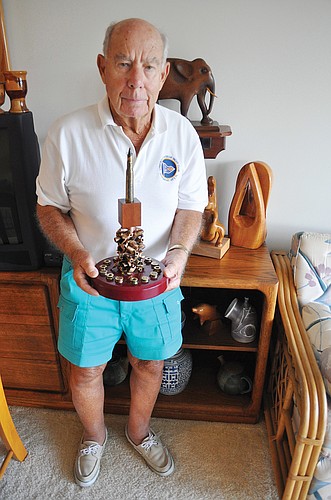- April 25, 2024
-
-
Loading

Loading

In 1978, New Jersey snowbirds Murray and Lorraine Brooks started taking frequent walks four to five miles north of their Longboat Harbour home; they went as far as Beer Can Island.
During one of these walks, Murray Brooks, now 91, spotted something that caught his eye, but he didn’t immediately know what it was.
“The more I thought about it, the irregularity and the brass — I knew it had to be bullet fragments,” he says. It was something he was familiar with after serving in the Air Force for four years.
From 1978 to the beach renourishment in the early ’90s, the Brookses collected 30 pounds of the corroded bits of metal. Most of it surfaced after storms, and most of the casings were uncovered when Brooks would go out clam digging. He never used a metal detector to find it.
Most of the bullets, marked with “42,” “43” and “44,” to signify the years they were manufactured, were from 50-caliber machine guns that were shot out of airplanes at targets on the beach when Longboat Key was used as a bombing and gunnery range. During World War II, the military would gate off a section of the Key for military drills for fighter pilots in the 717th base unit at Sarasota Army Airfield.
The retired principal collected the bits of metal like some people collect seashells. He brought them back to his home in New Jersey, where the collection would sit for 30 years. He didn’t know what to do with all of the fragments.
After the ’90s beach renourishment, fragments stopped washing up on the beach, so Brooks focused on a new hobby. Before becoming a principal, he taught industrial arts and wood shop and machine shop. In 1981, when he retired, he started woodcarving.
Today, his Longboat Key apartment is like a museum of his carvings. It’s full of dancing frogs, ducks carved on recycled wood, elephants and decorative dishes.
“It takes me a whole morning to dust,” his wife says. “He’s been busy for all these years!”
A few years ago, Brooks felt inspired. He took each of the salt-and-sand packed, corroded brass bits and wire-wheel polished them individually until they shone bright.
“I decided to use these pieces of brass to help design and create sculpted works of art,” he says.
He started stacking them on rods in intricate ways leading up the sides of a smooth sanded-and-stained base to another tier, and then topped them off with a casing. He has about seven sculptures completed.
He’s planning on making more by bringing the rest of his brass collection from New Jersey to Longboat Key.
“The only way to get it is to have a gunnery range over salt water,” Brooks says of his unique material.
Brooks assumes some fragments that haven’t fully deteriorated could be uncovered with enough digging, but he isn’t planning to pursue a search. Fragment-finding is a thing of the past for him — he still has bags full of bullets to work with in the future.
FIVE THINGS YOU DIDN'T KNOW ABOUT: Murray Brooks
• Murray Brooks also likes to collect sharks teeth and sand dollars.
• Brooks remembers when the Longboat Observer was one page folded in half.
• Brooks used to have a boat and would frequently go fishing and clamming.
• Brooks is in charge of the woodshop at Longboat Harbour.
• Brooks attained a commercial pilot's license and a flight instructor's rating, and now his two grandsons are taking flying lessons.